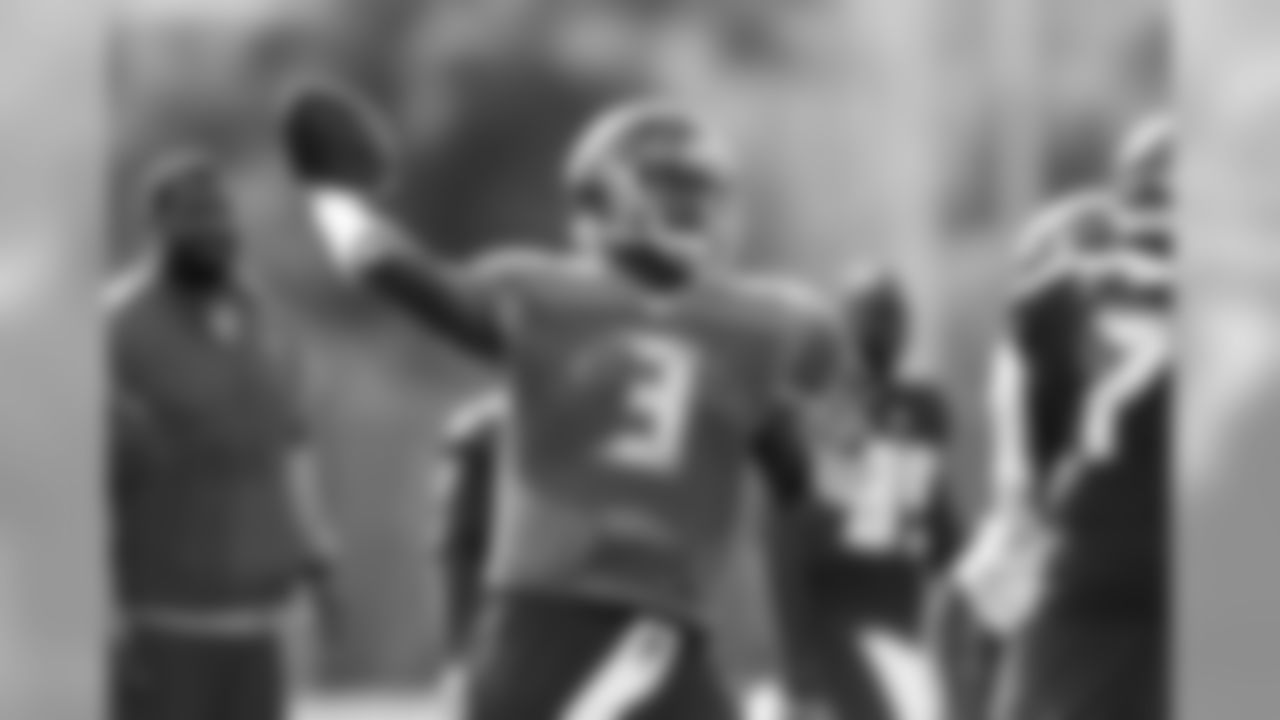Photos from the Bucs' practice on Wednesday, December 2nd, at One Buccaneer Place in Tampa.

















































Statistics can help illuminate the game of football…or they can take us down a misleading path. As Tampa Bay Buccaneers Head Coach Lovie Smith said: "I believe in stats, but it's [which] stats."
INFOGRAPHIC: BUCS-FALCONS SERIES HISTORY
Smith, for instance, doesn't pay much attention to the NFL's defensive rankings, since they are based on yards, which he considers a meaningless measure. When he shares defensive stats with his team, he focuses on points allowed, takeaways, scoring on defense and red zone proficiency.
Here on Buccaneers.com, we unabashedly love stats, but we also understand the need to wield them wisely. Sometimes, we can get a better feel for why the team is performing as it is by going a little deeper into the numbers. Other times, we simply want to point out a few numbers we consider interesting, and hope you will find it interesting as well.
That's our goal with Football Geekery. Each week, we're going to give you a sampling of statistical and/or historical analysis, hopefully in a way that is relevant to the Buccaneers' current state of affairs. This week, we take a look at a stat favored by many teams called Toxic Differential, define the company that the duo of Doug Martin and Mike Evans may soon be joining and share some impressive third-down numbers. Let's get started.
1. Toxic Numbers
Through 12 weeks, the Buccaneers' defense ranked 12th in the NFL. That's encouraging, but very much a surface statistic. The NFL's defensive rankings are based on yards allowed per game which, as we mentioned in the intro above, is not a statistical category the Buccaneers' coaching staff considers particularly relevant.
As Lovie Smith has stated on many occasions, his top priorities on defense is taking the ball away and turning those takeaways into points. On Thursday, Defensive Coordinator Leslie Frazier discussed another one of the Bucs' main defensive goals; essentially, it's not so much about how many yards you give up, but the manner in which you do so.
"When you run a scheme similar to ours the goal is to not give up those big chunks," said Frazier. "Right now I think we are leading the league in the least amount of explosive plays. You have to hold teams to field goals for that to be effective, if they are able to move the football. Philosophically you want to limit the amount of explosive plays whether it be in the passing game or run game and hold them to field goals and then find ways to take the ball away."
The Buccaneers define "explosive plays" as pass completions of 25 or more yards and runs of 15 or more yards and, indeed, Frazier's group has been the best in the NFL in preventing such "chunk" plays. The Bucs have allowed 21 explosive plays, just ahead of the Carolina Panthers' defense, which has given up 22. In fact, a list of the top 10 teams in that category doubles as a rundown, for the most part, of what are widely considered the best defenses in the NFL.
Fewest Explosive Plays Allowed, 2015
- Tampa Bay…21
- Carolina…22
- Cincinnati…27
- Seattle…28
5t. Minnesota…29
5t. Pittsburgh…29
7t. Arizona…31
7t. Denver…31
7t. St. Louis…31
10t. Atlanta…32
10t. Kansas City…32
If you combine the two concepts here – turnovers and big plays – and considers them from both an offensive and defensive perspective, then you have all the elements you need to track a statistic that is widely known as "Toxic Differential."
That term was coined by former Baltimore Ravens Head Coach Brian Billick, who began tracking the stat while he was the offensive coordinator for the Minnesota Vikings in 1998. Billick grew to be a big believer in the importance of Toxic Differential, which he says is a concept – not yet named – that had been "in circulation among coaches well before then."
As Billick's name for the concept suggests, it tracks both offensive and defensive numbers for a team and the difference between them. It's not a particularly complicated statistic. Takeaways minus giveaways gives you a team's turnover differential, which is half of the picture. Explosive plays created minus explosive plays allowed gives you the differential in that category, which is the other half of the picture. Add them together and you get the Toxic Differential.
For instance, the New York Giants have been very good at taking the ball away this year, with 23 turnovers created, and with only 13 giveaways they have a turnover differential of +10. However, they have allowed 40 explosive plays, 10 more than the Giants' offense has created, so their explosive play differential is -10. Add them together and New York is perfectly even in Toxic Differential, which is tied for 15th in the league.
The Buccaneers are doing well in Toxic Differential, which is a good sign for their ability to stay in the playoff race down the stretch. Tampa Bay currently ranks sixth in Toxic Differential (prior to the Thursday night Detroit-Green Bay game). The top 10 is populated mostly by teams that are firmly in the playoff race.
(Note: All of these numbers are created with explosive plays defined as 25+-yard completions and 15+-yard runs, which is what the Buccaneers' coaching staff tracks. The chart below would like change if one defined explosive plays differently.)
Top 10 Toxic Differential Teams, 2015
|
Team |
TA* |
GA* |
TO Diff. |
EP* |
EPA* |
EP Diff. |
Toxic Diff. |
|
28 |
12 |
16 |
34 |
22 |
12 |
28 |
|
20 |
8 |
12 |
41 |
32 |
9 |
21 |
|
3t. Pittsburgh |
18 |
17 |
1 |
48 |
29 |
19 |
20 |
|
3t. Seattle |
16 |
11 |
5 |
43 |
28 |
15 |
20 |
|
14 |
8 |
6 |
47 |
36 |
11 |
17 |
|
6. Tampa Bay |
20 |
18 |
2 |
35 |
21 |
14 |
16 |
|
7t. Cincinnati |
18 |
12 |
6 |
35 |
27 |
8 |
14 |
|
7t. Buffalo |
17 |
14 |
3 |
44 |
33 |
11 |
14 |
|
14 |
11 |
3 |
39 |
29 |
10 |
13 |
|
22 |
18 |
4 |
41 |
33 |
8 |
12 |
* TA = takeaways; GA = giveaways; EP = explosive plays; EPA = explosive plays allowed.
*^ Does not include the Week 13 Thursday night game
The undefeated Panthers are the only team in the league that is in positive double digits in both halves of Toxic Differential. Plenty of teams, like the Giants, fare well on one side of the equation but not the other. The St. Louis Rams, for instance, have a +5 mark in explosive play differential but are dead even in turnover ratio.
*
READ: FREEMAN EYES RETURN VS. BUCS*
Frazier brought up the topic of explosive plays while discussing the Buccaneers' 25-12 loss in Indianapolis in Week 12. Tampa Bay had a 12-6 lead at halftime of that game in part because they had kept the Colts from breaking off big plays and held strong in the red zone. However, Indy rallied for the win in the second half in large part because, for the first time in more than a year, the Buccaneers' defense did not record a single turnover.
*
The Bucs' current +2 mark in turnovers is decent; it's certainly better than being on the negative side of that ledger. However, it's fair to say that Smith and Frazier would like to see the team's takeaway totals go up by a significant margin. If they do, and the explosive play differential remains solidly in the Bucs' favor, that could prove to be a toxic combination for Tampa Bay opponents.
2. Four-Digit DuoRunning back Doug Martin is enjoying a fantastic season for the Buccaneers, and after his 97-yard effort in Indianapolis he ranks second in the NFL in rushing with 1,038 yards. Coupled with his 1,454-yard ground performance as a rookie in 2012, Martin is already one of just four players in franchise history with multiple 1,000-yard seasons.
READ: FALCONS SCOUTING REPORT
Wide receiver Mike Evans started the season slowly due to a hamstring strain but he has been piling up the yards lately. Over the last four weeks, only Pittsburgh's Antonio Brown (474) has more receiving yards than Evans' 404. That surge has taken Evans to 789 yards with five games to go and he needs to average just 42.2 yards per game the rest of the way to crack 1,000 yards for the second time in as many NFL seasons.
If Evans joins Martin in quadruple digits, it will mark just the fourth time the Buccaneers have had a 1,000-yard rusher and a 1,000-yard receiver in the same season. Martin has already been involved in one such pairing. The three instances so far:
|
Season |
Rusher |
Yards |
Receiver |
Yards |
|
1984 |
James Wilder |
1,544 |
Kevin House |
1,005 |
|
2005 |
Cadillac Williams |
1,178 |
Joey Galloway |
1,287 |
|
2012 |
Doug Martin |
1,454 |
Vincent Jackson |
1,384 |
It's worth noting that Martin is 26 years old and doesn't turn 27 until mid-January. Evans just turned 22 in August. None of the other three pairings in the chart above included two players who were both 26 or younger. Martin is slated to become an unrestricted free agent at season's end, but if he remains with the Buccaneers the franchise could have a double-digit duo for many years to come.
3. Third and Moving
Tampa Bay's offense has done a better job at converting on third downs in 2015 than it has at almost any point in team history. The Buccaneers rank 10th in the NFL with a conversion rate of 42.1%; if maintained, that would be the third-best full-season mark in franchise annals, following a 42.9% finish in 1984 and a 42.2% rate in 2010.
There is reason to believe, however, that the Buccaneers can improve that mark by season's end and challenge the franchise record. That reason: No team in the NFL has converted third downs better than the Buccaneers since the fourth week of the season.
The Bucs started slow in this regard, converting just 22.5% of their third-down tries through the first three games, including a 1-of-12 nadir in Week Three at Houston. Since then, Jameis Winston and company have been successful on almost half of their tries. Here are the top 10 teams in the NFL in terms of third-down conversion rate since Week Four:
|
Team |
Made |
Att. |
Pct. |
|
52 |
106 |
49.1% |
|
46 |
101 |
45.5% |
|
47 |
105 |
44.8% |
|
49 |
110 |
44.5% |
|
48 |
112 |
42.9% |
|
47 |
111 |
42.3% |
|
52 |
123 |
42.3% |
|
47 |
112 |
42.0% |
|
46 |
110 |
41.8% |
|
43 |
108 |
41.7% |
This has not been a matter of boom-or-bust games, with the offense clicking on third downs one week and struggling the next. Since Week Four, the Bucs have been remarkably consistent in that category, with a conversion rate of 45% or better in seven of the last eight games.
Additional breakdowns of the Bucs' third-down success show that the offense has done equally well in most situations:
- Needing 1-3 Yards: 51.4%
- Needing 4-6 Yards: 54.1%
- Needing 7-10 Yards: 40.0%
- Needing 11-20 Yards: 23.3%
- In the First Half: 43.3%
- In the Second Half: 40.5%
- On Rushing Plays: 46.7%
- On Passing Plays: 40.5%
One would expect a team's success rate to go down incrementally as the attempts get longer, but 40% from 7-10 yards and 23.3% from 11-20 yards is at least as impressive as the numbers on shorter attempts. For comparison's sake, the Bucs were successful at a rate of 36.2% and 10.9% in those two categories, respectively, last year. It is a little unusual that the team has done better from 4-6 yards than from 1-3, but that might suggest even more room for improvement. According to Statspass, Tampa Bay ranks 24th in the league in third-and-short conversion rate, but fifth on third-and-medium tries and third on third-and-long attempts.






















